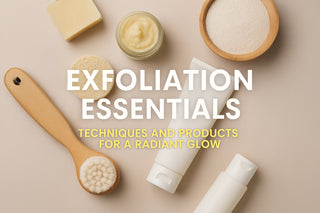If you’ve ever wondered why your skin looks dull, rough, or uneven despite your best efforts with cleansers and moisturizers, the missing step might be exfoliation. This crucial—but often misunderstood—part of a skincare routine is what helps your skin truly shine, both figuratively and literally. Exfoliation is the process of removing dead skin cells that accumulate on the surface of your skin, revealing a smoother, fresher, and more radiant complexion underneath. But it’s not just about scrubbing away dryness—it’s about doing it gently, effectively, and in a way that respects your skin’s natural barrier.
Why Your Skin Needs Exfoliation
Our skin naturally renews itself every few weeks, shedding dead skin cells to make room for new ones. However, this process slows with age, environmental stress, and certain skin conditions. When dead skin cells linger too long, they can clog pores, make the skin appear ashy or rough, and prevent your other skincare products from absorbing properly. That means all the serums and moisturizers you invest in may never reach their full potential.
Exfoliation helps stimulate cell turnover and clear away that buildup, which not only brightens the complexion but also smooths out texture, fades dark spots over time, and helps prevent breakouts. Think of it as hitting the reset button for your skin—it gives your face a fresh start.
Choosing the Right Method for You
There are two main ways to exfoliate: physical and chemical. Both can be effective when used properly, but they work in very different ways and are suited to different skin types.
Physical exfoliation involves manually buffing away dead skin cells using a scrub or tool. This could mean a facial scrub with fine, gentle particles (like sugar or rice powder), a textured washcloth, or a silicone cleansing brush. These methods provide instant smoothness but can be too abrasive for people with sensitive or acne-prone skin if used too aggressively or too often. If you do opt for a physical exfoliant, it’s important to avoid products with large, jagged particles that can create tiny tears in the skin’s surface.
Chemical exfoliation, on the other hand, uses acids or enzymes to dissolve the bonds that hold dead skin cells in place. Alpha hydroxy acids (AHAs) like glycolic or lactic acid are water-soluble and work well for brightening and softening dry or aging skin. Beta hydroxy acids (BHAs), such as salicylic acid, are oil-soluble and can dive deep into pores, making them ideal for oily or acne-prone skin. Enzyme exfoliants, often made from fruit extracts like papaya or pineapple, are even gentler and perfect for those with easily irritated skin.
Frequency and Technique Matter
One of the most common mistakes people make with exfoliation is doing it too often. It’s easy to assume that more exfoliation means faster results, but overdoing it can lead to redness, dryness, and even a damaged skin barrier. Most people only need to exfoliate two or three times per week, though those with sensitive or dry skin might want to limit it to just once a week.
Regardless of the method, exfoliation should always be done gently. For scrubs, use light circular motions with your fingertips—never scrub harshly. For chemical exfoliants, follow the directions carefully and start with a low concentration. You can gradually increase frequency or strength once you know how your skin responds. After exfoliating, always apply a nourishing moisturizer to help your skin recover and retain hydration. And never skip sunscreen—freshly exfoliated skin is more sensitive to sun damage.
Don’t Forget the Rest of Your Body
Exfoliation isn’t just for your face. Your body benefits from it too, especially areas prone to dryness or buildup, like elbows, knees, and feet. Using a salt or sugar scrub in the shower once or twice a week can keep your skin soft and smooth. If you’re dealing with keratosis pilaris (those tiny bumps on your arms or thighs), a body lotion with a mild chemical exfoliant like lactic acid can help smooth things out over time.
Even your lips can benefit from gentle exfoliation. A soft toothbrush or a DIY sugar-and-honey scrub can remove flaky skin and leave your lips looking plump and healthy—just follow up with a balm to lock in moisture.
The Takeaway
Exfoliation is one of those small additions to your routine that can deliver outsized results. When done correctly, it enhances your skin’s natural glow, improves texture, helps clear breakouts, and allows your other products to work more effectively. The key is to exfoliate with intention, not aggression—respecting your skin’s pace and giving it what it needs without overloading it.
A radiant complexion isn’t the result of a single product—it’s a reflection of consistent care, smart choices, and a little patience. And when you make exfoliation a part of that routine, you’re giving your skin the opportunity to look and feel its absolute best.

